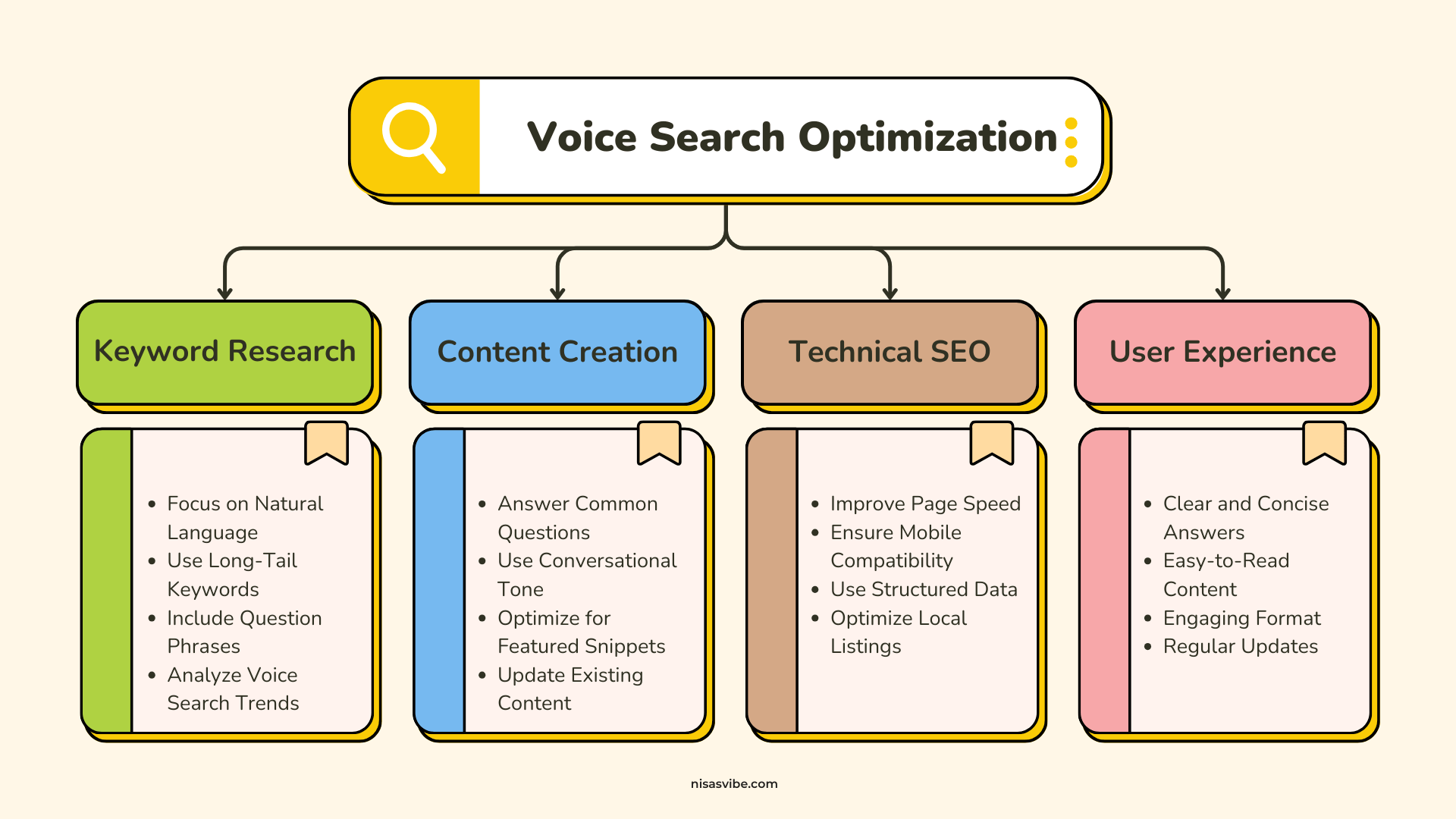Hi, I’m Nisa, a digital marketer and the proud owner of Perfect Prints of Love and nisasy.com. As an online business owner and marketer, I’ve seen firsthand how the digital landscape is evolving, and voice search is one of the most exciting changes that will impact 2025 and beyond. With the increasing popularity of voice-activated devices like Alexa, Google Assistant, and Siri, voice search is transforming the way consumers interact with the web, and optimizing for it is becoming essential for any business owner.
In this article, I’ll share insights into voice search optimization for 2025, strategies you can implement today, and how I’ve been leveraging these tactics to grow my business and stay ahead of the competition. By adapting to these changes, you can make sure your business stays relevant and continues to attract valuable customers in the evolving search ecosystem.
Table of Contents
1. The Growing Importance of Voice Search
Voice search is no longer a novelty. As we approach 2025, voice-activated devices are becoming embedded in nearly every facet of daily life. With the rise of smart speakers, wearables, and smartphones, voice search is transforming the way users search for information, products, and services.
Why Voice Search is Gaining Traction:
- Convenience and Speed: People use voice search because it’s hands-free and quick—perfect for multitasking. Whether driving, cooking, or exercising, voice search allows users to get information instantly.
- Voice-First Devices: Devices like Amazon Echo, Google Home, and smartphones are widely used in homes and businesses, providing a great opportunity for businesses to be discovered through voice search queries.
- Improved Accuracy: As speech recognition and natural language processing (NLP) technologies improve, voice search is becoming more accurate and reliable, encouraging greater user adoption.
From my experience managing nisasy.com, I can attest to how voice search has impacted consumer behavior. As a small business owner, it’s important to stay ahead by ensuring that your content is discoverable through voice search.
2. Why Voice Search Optimization Matters for 2025
Voice search is significantly different from traditional typing search. In 2025, it will continue to dominate, especially as voice-enabled devices become more affordable and widely adopted.
Voice Search vs. Traditional Search:
- Conversational Queries: Voice search tends to use natural language and longer, more conversational phrases like “Where can I buy eco-friendly products near me?” as opposed to typed queries like “buy eco-friendly products.”
- Local Intent: A large portion of voice searches are location-based. For example, a user might say, “Find a local wedding invitation shop.” As a business, optimizing for these local queries can help you stand out in the competitive digital market.
- Featured Snippets and Instant Answers: Voice assistants often pull answers directly from featured snippets, which means that being featured in this section increases the chances of your business appearing in voice search results.
By optimizing for voice search, businesses like mine can increase visibility and ensure that our customers find us when they use voice assistants to make purchasing decisions.
3. Effective Strategies for Optimizing Your Content for Voice Search
Now that we understand why voice search optimization is essential, let’s explore the strategies that will help you stay ahead of the competition in 2025.
Focus on Long-Tail Keywords and Natural Language
Voice search is inherently more conversational, which means users are likely to ask complete questions. These queries tend to be long-tail keywords, often including phrases like “how to, what is, where can I, etc.”
How to Implement:
- Research and use question-based keywords in your content. For example, instead of targeting “wedding invitations,” aim for keywords like “best personalized wedding invitations near me.”
- Use tools like Answer the Public to generate ideas for natural, conversational search queries that people might use in voice searches.
- Incorporate phrases that are colloquial and conversational, mimicking how people speak.
My Thoughts: This strategy has helped me target voice search queries on both my Etsy store and nisasy.com, which has significantly boosted my traffic.
Optimize for Local SEO
Many voice searches are location-specific, especially for users looking for businesses nearby. Optimizing your content for local SEO can significantly improve your chances of ranking for voice search queries.
How to Implement:
- Google My Business (GMB): Claim and optimize your Google My Business profile with accurate business hours, location, services, and customer reviews. This is crucial for local voice search visibility.
- Use local keywords and location-based phrases in your website’s content. For example, I target keywords like “eco-friendly products in New York” on nisasy.com to improve my local SEO.
- Ensure your Name, Address, and Phone Number (NAP) are consistent across all online directories and platforms.
My Thoughts: Local SEO has been a game-changer for driving foot traffic to my Etsy shop and nisasy.com, especially when customers use voice search to find local businesses.
Create Conversational, User-Friendly Content
Voice search queries tend to be more natural and conversational, so it’s essential that your content reflects this shift.
How to Implement:
- Use a conversational tone in your website content, product descriptions, and blog posts. Address the reader as if they are asking questions, and provide clear answers.
- Include FAQs on your site that specifically address the questions your audience might ask via voice search. I’ve found that adding an FAQ section to my product listings on Etsy helps drive more targeted traffic.
My Thoughts: Being user-friendly and conversational has not only improved my voice search optimization but has also enhanced the overall customer experience on my websites.
Improve Website Speed and Mobile Optimization
Voice search is designed for quick answers, so if your website doesn’t load fast, you may lose out on potential customers. Ensuring that your website is mobile-friendly and fast-loading is essential for voice search optimization.
How to Implement:
- Use tools like Google PageSpeed Insights to identify and fix issues that could slow down your website.
- Make sure your website design is responsive so that it provides a smooth user experience on mobile devices and smart speakers.
My Thoughts: Website speed has been a key focus for me, especially as I rely on mobile traffic. Improving speed has not only helped with voice search but also enhanced my overall user experience.
Use Structured Data Markup (Schema)
Structured data (schema) is a powerful tool that helps search engines better understand your content. It plays a crucial role in ensuring that voice search devices pull accurate and relevant information.
How to Implement:
- Use schema markup to provide search engines with information about your products, services, location, reviews, and FAQs.
- Tools like Google’s Structured Data Markup Helper can make adding schema to your website easier.
My Thoughts: Adding schema markup to my website was a significant step in improving search visibility for my products and services, especially for voice queries.
4. Tools and Resources for Voice Search Optimization
To make voice search optimization easier, here are a few tools that can help:
- Google Search Console: Monitor performance for voice-related keywords and identify opportunities for optimization.
- Moz: Analyze long-tail and conversational keyword opportunities.
- Answer the Public: Get a list of common questions and long-tail keyword ideas based on real user searches.
- Schema.org: Add structured data to your website for better voice search visibility.
5. Measuring the Success of Your Voice Search Strategy
As with any marketing strategy, it’s crucial to measure your progress. You can track how well your content is performing in voice search results using various metrics.
Metrics to Monitor:
- Search Rankings: Track your voice search rankings using tools like SEMrush or Moz.
- Organic Traffic: Keep an eye on changes in traffic from mobile and local searches.
- Engagement: Measure user engagement, including bounce rate, time on page, and conversion rates, to see how well your voice-optimized content is performing.
Preparing for the Future of Voice Search
Optimizing for voice search in 2025 is no longer optional—it’s essential for staying competitive. By focusing on long-tail keywords, creating conversational content, and leveraging local SEO and structured data, you can ensure your business is ready for this growing trend.
As a digital marketer and business owner, I’ve already begun optimizing my content for voice search, and it’s been incredibly beneficial. The key is preparing now for the future, so your business remains discoverable as more and more customers turn to voice search.




